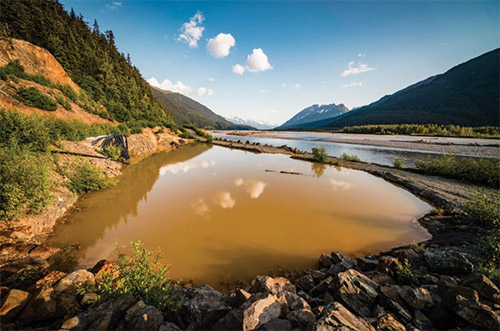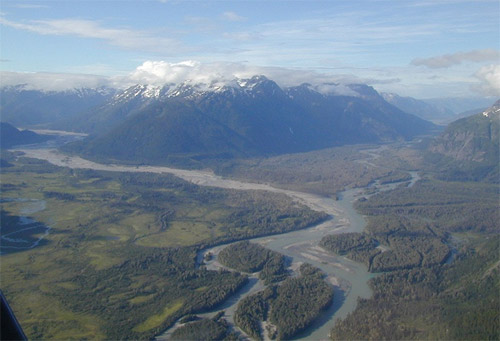Runoff from the Tulsequah Chief mine, southwest of Atlin, B.C. flows into the Tulsequah River, about 6.2 miles upstream from its confluence with the Taku River, which flows into Southeast Alaska. |
British Columbia on August 12, 2022 announced the end of the bankruptcy receivership for Chieftain Metals, owner of the abandoned Tulsequah Chief mine. The receivership hindered B.C.’s efforts to clean up the site and was the major obstacle in the way of mine closure and cleanup. Now that receivership is over, the Taku River Tlingit First Nation, the Douglas Indian Association and the Southeast Indigenous Transboundary Commission (SEITC) are calling on the B.C. government to honor its commitment to end decades of toxic acidic mine discharge into the transboundary Taku watershed.
The Tulsequah Chief Mine is a historic underground copper/lead/zinc mine which was operated by Cominco from 1951 to 1957. The mine is located on the Tulsequah River about 6.2 miles upstream from its confluence with the Taku River, in the traditional territory of the Taku River Tlingit First Nation.
“This is very good news. The receivership hindered B.C.’s efforts to stop the pollution from Tulsequah Chief and clean up the site and was the major procedural hurdle to clear. Now, our First Nation and Alaska Native Tribal governments call on B.C. to start taking specific steps toward turning its commitments into action,” said Charmaine Thom, Taku River Tlingit First Nation Spokesperson.
“We are celebrating this long overdue step. We strongly support the TRTFN and will do all we can to ensure B.C. makes good on its commitment to solve the Tulsequah Chief problem. In 2015, then B.C. Mines Minister Bill Bennett came to Juneau and promised to address this situation; seven years later we are still waiting,” said Douglas Indian Association President Clarence Laiti.
“Salmon and other traditional foods are the foundation of our culture and transboundary rivers such as the Taku have nourished our communities since time immemorial. We are in solidarity with the TRTFN and urge the B.C. government match its commitments with real on the ground action to clean up the Tulsequah Chief mine,” said Southeast Indigenous Transboundary Commission Chair Robert Sanderson, Jr.
“We’re thrilled that the last bureaucratic hurdles are being cleared and we urge the B.C. government to move quickly to fix this decades-long mess,” said Breanna Walker, director of Salmon Beyond Borders. “While we are optimistic this source of acid mine waste contamination will soon be brought under control, it does not obscure the fact this took far too long and much larger mines loom on the horizon."
Elsewhere in the Taku watershed, as well as the transboundary Stikine and Unuk river systems, a modern day gold rush is underway.
“In the Taku watershed alone, B.C. is allowing mining speculators to stake hundreds of square miles of claims literally right up to the U.S. border — and the situation is even worse in the Stikine and Unuk watersheds,” said Walker. “In the Unuk, for example, 88% of the B.C. side of the watershed is staked with B.C. mining claims. We waited 65 years for B.C. to initiate cleanup of Tulsequah Chief, and it was a tiny mine compared to those now operating and planned in the transboundary region.”
The Taku River. |
In response to the growing upstream threats, communities across Southeast Alaska have passed resolutions calling for a “time out” on mineral claim staking and development and a tailings dam ban in watersheds shared by the two countries.
“It is long past time for all of us connected to these special places to have a seat at the table,” Walker concluded.
Quoting a Taku River Tlingit First Nation and Douglas Indian Association news release, this mine has been discharging toxic acid mine drainage into the Taku watershed for 65 years. The Taku River is extremely important to Tlingit people on both sides of the border. Tulsequah Chief is in the territory of the Taku River Tlingit First Nation based in Atlin, B.C. The DIA is the federally recognized Tribe with ties to the downstream Alaska side of the Taku. SEITC is a consortium of 15 sovereign Tribal nations in Southeast Alaska, including DIA.
In 2016 mine owner Chieftain Metals sought bankruptcy protection and a receivership process was established. In 2020 a Canadian bankruptcy court ruled that the receivership was to be ended but that it could be re-started within two years. That deadline passed on August 11. The court also ruled that the dissolution of Chieftain Metals would be stayed until October 2022. The release of the draft mine remediation plan in August 2020, securing of initial funding to carry out further studies, and getting a crew on site to begin stabilization and cleanup efforts, were important initial steps taken by B.C. but the receivership has hindered more extensive efforts.
The Taku River Tlingit First Nation and Douglas Indian Association said they would like to see B.C. accomplish the following as soon as possible:
-
formal announcement from B.C. that the receivership is over and that the responsibility for the
closure and cleanup is being taken on;
-
the dissolution of Chieftain Metals as a company in October;
-
revoke Chieftain’s mine permits and transfer them to the B.C. government;
-
development of a plan specifically for the cleanup timelines;
-
development of a plan specifically for funding the cleanup and closure;
-
continued and enhanced engagement with affected First Nations and Tribes; and
- complete needed studies.
As previous Taku River Tlingit First Nation Spokesperson Ward testified to the bankruptcy court in July 2020 “The name Tulsequah is based on the Tlingit name for this area, Taas Teiyi Heeni, which means Root Garden River...In addition to the Tulsequah Valley being a core traditional use landscape, it also contains many culturally important places such as camp sites and settlements. While we historically used the area around the Tulsequah Mine site, currently we are not able to exercise khustiyxh [way of life] and our Aboriginal rights there due to the environmental contamination.”
“Today, Tlingit people come together to urge that, with the end of the receivership, B.C. begin taking concrete steps toward honoring its commitments to mine cleanup. Alaskan and U.S. federal attention to this issue has been an important factor in progress to date, and we urge continued cross-border engagement on behalf of the Taku from the people who call it home,” said Douglas Indian Association President Laiti.
“The abandoned mine has now been polluting the Taku watershed for sixty-five years. As Chinook salmon runs decline elsewhere along the West Coast due to multiple environmental factors, closure and cleanup of Tulsequah Chief will help ensure that the Taku remains a world class international salmon river system of profound cultural significance to the First Nation and Tribes,” said Southeast Indigenous Transboundary Commission Chair Sanderson.
Source of News:
Douglas Indian Association
www.diataku.comSoutheast Indigenous Transboundary Commission
www.seitc.orgTaku River Tlingit First Nation
www.trtfn.comSalmon Beyond Borders
www.salmonstate.org
Representations of fact and opinions in comments posted are solely those of the individual posters and do not represent the opinions of Sitnews.
Send a letter to the editor@sitnews.us
SitNews ©2022
Stories In The News
Ketchikan, Alaska
Articles & photographs that appear in SitNews are considered protected by copyright and may not be reprinted without written permission from and payment of any required fees to the proper freelance writers and subscription services.
E-mail your news & photos to editor@sitnews.us
Photographers choosing to submit photographs for publication to SitNews are in doing so granting their permission for publication and for archiving. SitNews does not sell photographs. All requests for purchasing a photograph will be emailed to the photographer.


